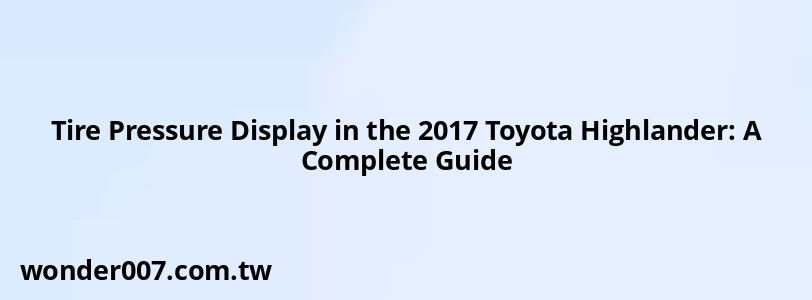Tire Pressure Display in the 2017 Toyota Highlander: A Complete Guide

The 2017 Toyota Highlander features a Tire Pressure Monitoring System (TPMS) designed to alert drivers when tire pressure is low. This system is crucial for maintaining vehicle safety and performance, making it essential for Highlander owners to understand how to access and interpret tire pressure information.
Understanding the Tire Pressure Monitoring System (TPMS)
The TPMS in the 2017 Highlander utilizes sensors installed in each tire to monitor air pressure and temperature. These sensors communicate wirelessly with the vehicle's onboard computer, which displays tire pressure readings on the dashboard. If tire pressure falls below a predetermined threshold, a warning light illuminates on the instrument panel.
Important Info: The TPMS can only function correctly if tire pressures are set within the specified range. If the system is initialized without proper tire inflation, it may not provide accurate warnings.Accessing Tire Pressure Information
To view tire pressure readings, drivers can use several methods:
- Multi-Information Display: This is typically found on the dashboard. By navigating through the display options using steering wheel controls, drivers can find real-time tire pressure information for each tire.
- Tire Pressure Warning Light: If this light illuminates, it indicates that one or more tires are under-inflated. It’s important to check pressures immediately.
- Toyota App (if subscribed): For those with an active service subscription, the Toyota app can provide tire pressure readings remotely.
Resetting the TPMS
If you have recently changed tires or adjusted their pressures, you may need to reset the TPMS. Here’s how:
1. Set all tires to the recommended cold pressures.
2. Turn the ignition ON (but do not start).
3. Press and hold the tire pressure warning reset switch until the warning light blinks three times.
4. Turn off the ignition.
5. Drive for approximately 20 minutes to allow the system to recalibrate.
This process ensures that the system recognizes new tire pressures and functions accurately.
Common Issues and Troubleshooting
If your TPMS light remains illuminated or if dashes appear instead of pressure readings, consider these troubleshooting steps:
- Check Tire Pressures Manually: Use a reliable gauge to confirm that all tires are properly inflated.
- Reinitialize System: Follow the reset procedure above to ensure that all sensors are calibrated correctly.
- Consult a Professional: If problems persist, there may be issues with the sensors or other components of the TPMS that require professional diagnosis.
FAQs About Tire Pressure Display in 2017 Toyota Highlander
- How do I know if my tire pressure is low?
The TPMS warning light will illuminate on your dashboard if any tire is under-inflated. - What should I do if my TPMS light stays on?
Check your tire pressures manually and reset the TPMS if necessary. - Can I check my tire pressure remotely?
Yes, if you have an active subscription to Toyota's service, you can use their app for remote monitoring.
Related Posts
-
2012 Toyota Camry Hybrid Starting Issues: Solutions
26-01-2025 • 170 views -
Ford Focus Clutch Position Sensor B Location Guide
29-01-2025 • 310 views -
2016 Hyundai Tucson Driver Window Not Working: Troubleshooting Guide
30-01-2025 • 188 views -
Hyundai Tucson Door Handle Button Replacement Guide
29-01-2025 • 215 views -
Oil Filter for 2008 Ford Escape: Your Complete Guide
26-01-2025 • 176 views
Latest Posts
-
How To Turn Off Paddle Shifters Mercedes
01-02-2025 • 377 views -
Are O2 Sensors Covered Under Warranty
01-02-2025 • 376 views -
2015 Chevy Traverse AC Recharge Port Location
01-02-2025 • 409 views -
Rear Brake Caliper Piston Won't Compress
01-02-2025 • 356 views -
Power Steering Fluid Leak On Passenger Side
01-02-2025 • 457 views
Popular Posts
-
Power Steering and ABS Light On: Causes and Solutions
27-01-2025 • 643 views -
EPC Warning Light: What It Means for Your Vehicle
27-01-2025 • 630 views -
Hino Warning Lights: Understanding Dashboard Alerts
26-01-2025 • 765 views -
EPC Light: Understanding Causes and Solutions
26-01-2025 • 1053 views -
V12 Engine Costs: What You Need to Know
26-01-2025 • 679 views
